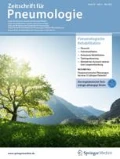Zusammenfassung
Die Maßnahmen bei inhalativen Allergien umfassen solche zur Prävention, die Pharmakotherapie mit Antiobstruktiva und antiinflammatorisch wirkenden Substanzen sowie die spezifische Immuntherapie (SIT). Eine weitere Option ist die Therapie mit Omalizumab, die aber nur in schwierigen, nicht anders beherrschbaren Fällen von allergischem Asthma zum Einsatz kommt. Die Vermeidung von Tabakrauchexposition ist die wichtigste und am einfachsten realisierbare Karenzmaßnahme. Die antiinflammatorische Therapie besitzt einen hohen Stellenwert und kommt bereits in Stufe 2 der insgesamt 5 Stufen umfassenden Therapie des Asthma zum Einsatz. Auch bei der Behandlung der allergischen Rhinokonjunktivitis ist der Stellenwert der topischen Kortikoide gestiegen. Die SIT als kausaler Therapieansatz ist bei der allergischen Rhinitis in beiden Applikationsformen effizient, bei Asthma jedoch weniger wirksam. Die Wertigkeit der sublingualen Therapie bei Asthma bronchiale erlaubt noch keine endgültige Beurteilung.
Abstract
Management of respiratory allergies comprises prevention of exposure to allergens, pharmacologic treatment with controllers and relievers and specific immunotherapy (SIT). Omalizumab is an immunomodulating agent the use of which is confined to asthma which cannot otherwise be treated. Avoiding exposure to tobacco smoke is easily implemented and effective. Controlling airway inflammation primarily by inhaled glucocorticosteroids is of high significance and is already to be applied at step 2 in a 5-step treatment. In managing allergic rhinitis topical glucocorticosteroids are likewise of high significance. The SIT as a causal approach is proven in either form of application in treatment of rhinitis but the efficacy in asthma is still limited. Concerning sublingual immunotherapy (SLIT) in treatment of asthma a conclusive appraisal is not yet permitted.


Literatur
Bundesärztekammer (BÄK), Kassenärztliche Bundesvereinigung (KBV), Arbeitsgemeinschaft der Wissenschaftlichen Medizinischen Fachgesellschaften (AWMF) (2011) Nationale Versorgungsleitlinie Asthma – Langfassung, 2 Aufl. Version 1.3, 2011 [cited: 01.02.2012]. Available from: http://www.versorgungsleitlinien.de/themen/asthma, Internet: http://www.versorgungsleitlinien.de, http://www.awmf-leitlinien.de
Muche-Borowski C, Kopp M, Reese I et al (2009) S3-Leitlinie Allergieprävention – Update 2009. Allergo J 18:332–341
Fisk WJ, Lei-Gomez Q, Mendell MJ (2007) Meta-analyses of the associations of respiratory health effects with dampness and mold in homes. Indoor Air 17:284–296
Ring J, Bachert C, Bauer CP et al (2010) Weißbuch Allergie in Deutschland. 3. überarbeitete und erweiterte Aufl., Springer Medizin
Gǿtzsche PC, Johansen HK (2008) House dust mite control measures for asthma: systematic review. Allergy 63:646–659
Schultze-Werninghaus G, Berdel D (2008) Primär-, Sekundär- und Tertiärprävention bei Asthma – ist ein Paradigmenwechsel angesagt? Allergo J 17:316–330
Schulz C (2011) Asthma des Erwachsenen. Aktuelle Therapierichtlinien. Pneumologe 8(4):273–284
Bousquet J, Khaltaev N, Cruz AA et al (2008) Allergic rhinitis and its impact on asthma (ARIA) 2008 Update. Allergy 63(Suppl. 86):8–160
Kleine-Tebbe J, Bufe A, Ebner C et al (2009) Die spezifische Immuntherapie (Hyposensibilisierung) bei IgE-vermittelten allergischen Erkrankungen. Allergo J 18:508–537
Brozek JL, Bousquet J, Baena-Cagnani CE et al (2010) Allergic rginitis and its impact on asthma (ARIA) guidelines: 2010 Revision. J Allergy Clin Immunol 126:466–476
Abramson MJ, Puy RM, Weiner JM (2010) Allergy immunotherapy for asthma. Cochrane Database Syst Rev (4):CD001186
Cox L, Li JT, Nelson H et al (2007) Allergen immunotherapy: a practice parameter second update. J Allergy Clin Immunol 120:S25–85
Amin HS, Liss GM, Bernstein DI (2006) Evaluation of near-fatal reactions to allergen immunotherapy injections. J Allergy Clin Immunol 117:169–175
Klimek L, Pfaar O (2011) Spezifische Immuntherapie: aktuelle Entwicklungen und Zukunftstrends. Allergo J 20:452–459
Dahl R, Stender A, Rak S (2006) Specific immunotherapy with SQ standardized grass allergen tablets in asthmatics with rhinoconjunctivitis. Allergy 61:185–190
Incorvaia C, Riario-Sforza GG, Incorvaia S et al (2010) Sublingual immunotherapy in allergic asthma: current evidence and needs to meet. Ann Thorac Med 5:128–132
Merck HF, Jung K (2011) Erklärung des Ärzteverbandes Deutscher Allergologen zur spezifischen Immuntherapie. Allergo J 20:108
Gemeinsamer Bundesausschuss (G-BA) Beschluss des Gemeinsamen Bundesausschusses über eine Änderung der Arzneimittel-Richtlinie in Anlage IV: Therapiehinweis zu Omalizumab vom 11. November 2010 (2011) Dtsch Ärztebl 108(11):B488–B492
Bergmann K-C (2011) Das Netzwerk „Schweres Allergisches Asthma“ in Deutschland. medical spezial 1:9–10
Rodrigo GJ, Neffen H, Castro-Rodriguez A (2011) Efficacy and safety of subcutaneous omalizumab vs placebo as add-on therapy to corticosteroids for children and adults with asthma. Chest 139(1):28–35
Tillie-Leblond I, Germaud P, Leroyer C et al (2011) Allergic bronchopulmonary aspergillosis and omalizumab. Allergy 66:1252–1259
Pelaia G, Gallelli L, Renda T et al (2011) Update on optimal use of omalizumab in management of asthma. J Asthma Allergy 4:49–59
Interessenkonflikt
Der korrespondierende Autor gibt an, dass kein Interessenkonflikt besteht.
Author information
Authors and Affiliations
Corresponding author
Rights and permissions
About this article
Cite this article
Weber, N. Pneumologische Allergologie II. Pneumologe 9, 475–486 (2012). https://doi.org/10.1007/s10405-012-0584-0
Published:
Issue Date:
DOI: https://doi.org/10.1007/s10405-012-0584-0

